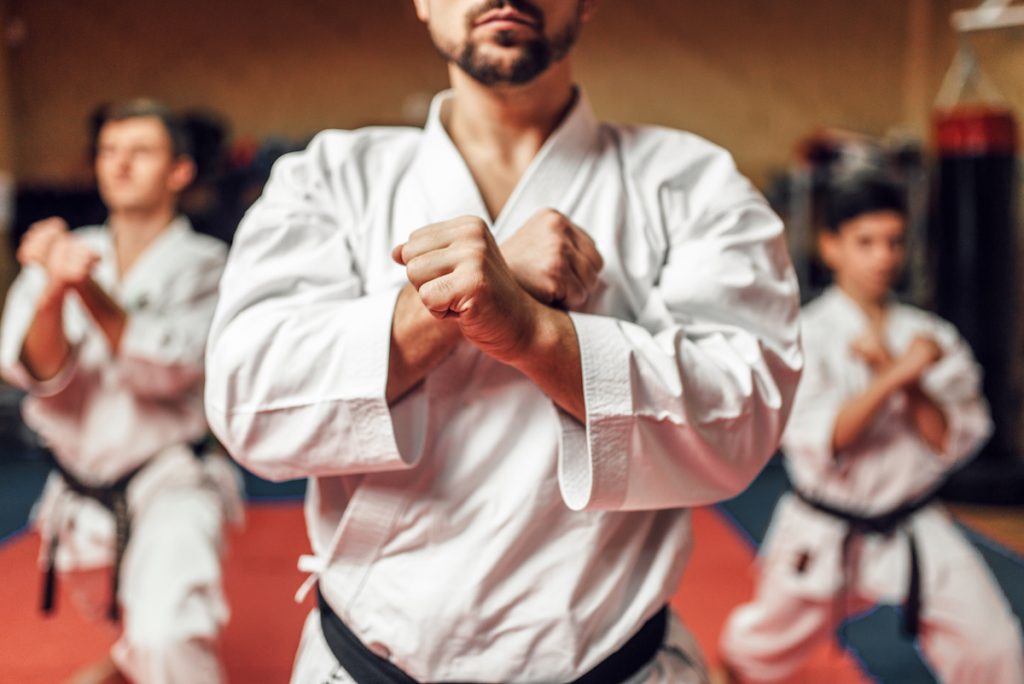It does not matter where you have seen martial arts, whether on the television, in a movie, or a studio. It is likely, even if only subconsciously and then dismissed, you noticed everyone wearing the same uniform. In this blog, we begin to unwrap the gi. Looking at its design, purpose, name, and what it represents both in and out of the studio. Everything in martial arts is intentional and purposeful, giving depth to the practice and history.
Anyone training in martial arts will wear a gi short for \”keikogi.\” Keikogi means practice clothes. “Keiko” means practice, and \’gi\” means clothing or attire. Traditionally white, the gi can also be seen in black and variations of blue. The white gi is the most common in martial arts with roots in the Japanese culture, representing purity and truth. The black and blue gi may represent a rank within a studio or be seen during tournaments to distinguish competitors.
The gi has bottoms, referred to as “shitabaki” or “zubon,\” meaning underpants or trousers. The top part of the gi is called the “uwagi,\” meaning upper, appropriate since it is the top part of the gi uniform.
Most beginning students start with a single weave gi depending on the studio. It is light, easy to practice in, easy to wash, and easy to replace. More expensive gi uniforms come in double weave, gold weave, or platinum. The weight of the Gi varies most, and even though the weave variation is often chosen depending on the discipline and style of the martial art, all weave options are designed to match the style. There are also seasonal benefits to various weaves because a heavier weave will be better in colder climates, where a single weave is cooler and better in warmer temperatures. In hotter climates, studios may offer t-shirts to be worn with the bottoms to allow comfort but maintain uniformity.
Designed with Purpose
The weight and weave are designed to allow the best movement for each style. In a studio that offers training in multiple styles, such as SwiftKick, the single weave gi will enable students to train in Karate, Jiu-jitsu, MMA, Krav Maga, kickboxing, and more.
It is understood that when designed, the gi was to provide martial art students with functional practice clothes to help refine and perfect self-defense techniques, such as escaping holds. The gi fit allows for the full range of motion, avoiding the likelihood of ripping or tearing. As martial arts training intensifies, having material and fit that can withstand a rigorous workout is essential. Most studios will require students to wear a gi during training, and multiple reasons for this are covered later. The gi is part of the sign-up fees when joining SwiftKick, Martial Arts, so those in training do not have to go out and find one on their own. Providing students with a gi is something that the owner, Brian, and his team have found incredibly helpful. In doing so, students are equipped with exactly what they need.
Named with Purpose
The gi is used in different martial arts styles and varies slightly in the name. For example, the Aikido gi is named Aikidogi, and the karate gi is Karategi. The Brazilian gi is also called a kimono. Again, a beginning student in martial arts training will not be required to distinguish the different names for each discipline. The overall design of the Gi allows it to be functional and durable regardless of the level or style of martial arts.
Representing with Purpose
When someone in martial arts training changes out of street clothes and puts on their gi, it is a physical representation that the environment is different. It is a tool that helps students shift their mindset, set aside the day\’s stresses, and focus on a successful training session. Wearing a gi shows uniformity and provides all students a sense of order with minimal distractions. Any student wearing a gi also shows their commitment to wearing the appropriate attire explicitly designed for training. The gi has been purposefully designed and chosen to allow those in training to maximize their workout with comfort and agility. If there is a variation of gi colors within the studio, it is often reserved for a certain level of student and determined in each studio individually. The color of a gi in a martial arts studio can also show rank immediately, which helps those in training.
A reputable and experienced studio will always provide students with the materials they need. It is helpful to try out a free class at a local studio and make sure the environment is welcoming and friendly. There is a range of studios out there but finding one that makes you feel comfortable, offers a sanitary and professional environment is critical. SwiftKick provides a free trial class for anyone interested in exploring martial arts.
What is worn under the gi is a personal choice. However, due to the design of the gi to maximize flexibility, it doesn’t make much sense to wear a tight-fitting workout outfit underneath. Use your discretion when deciding what to wear underneath, and make sure your gi covers up any dark colors! When the gi is worn, it represents both martial arts and the studio you are associated with.
Who knew there was so much to know about the practice uniform for martial arts? Knowledge is power, and now you know much more about the “keikogi\” or \”gi.\” Overall, the gi is comfortable and easy to care for. It is best to wash it after each use (although this is not always an option), not bleached, and if you can avoid high heat in the dryer, it will last for as long as you need it.

